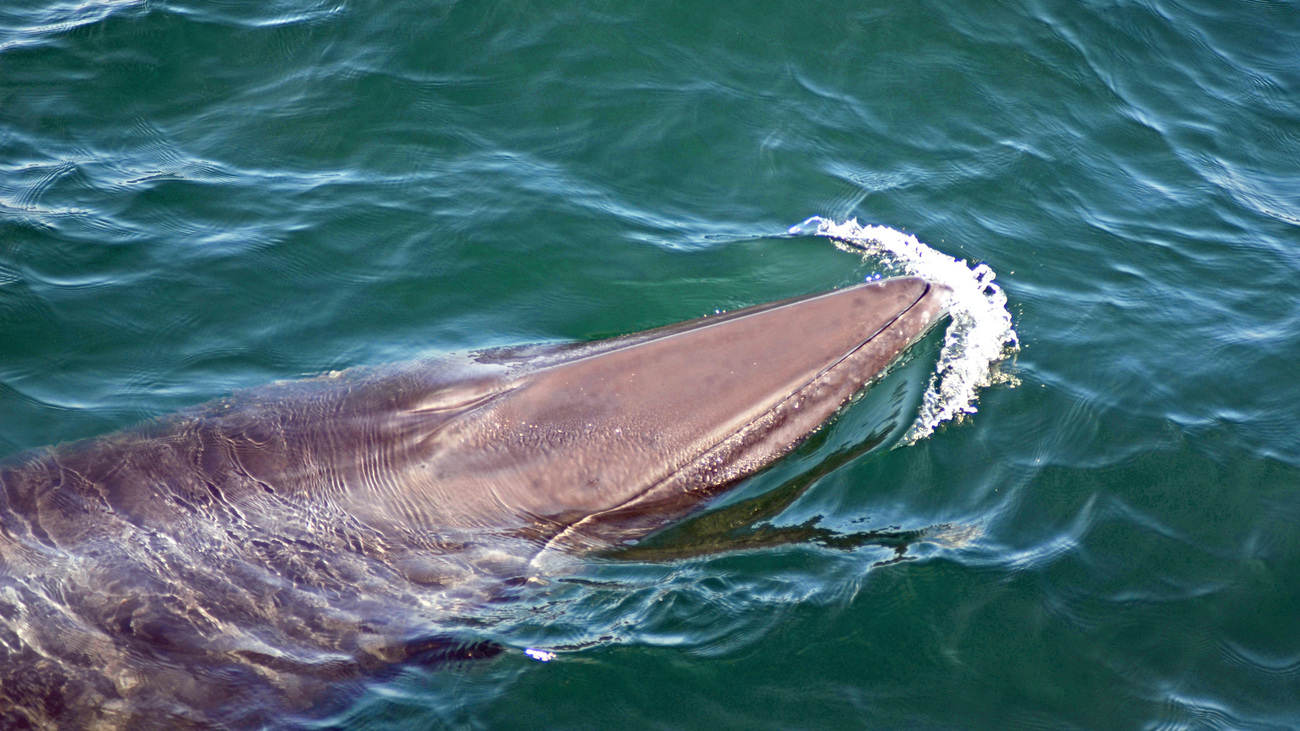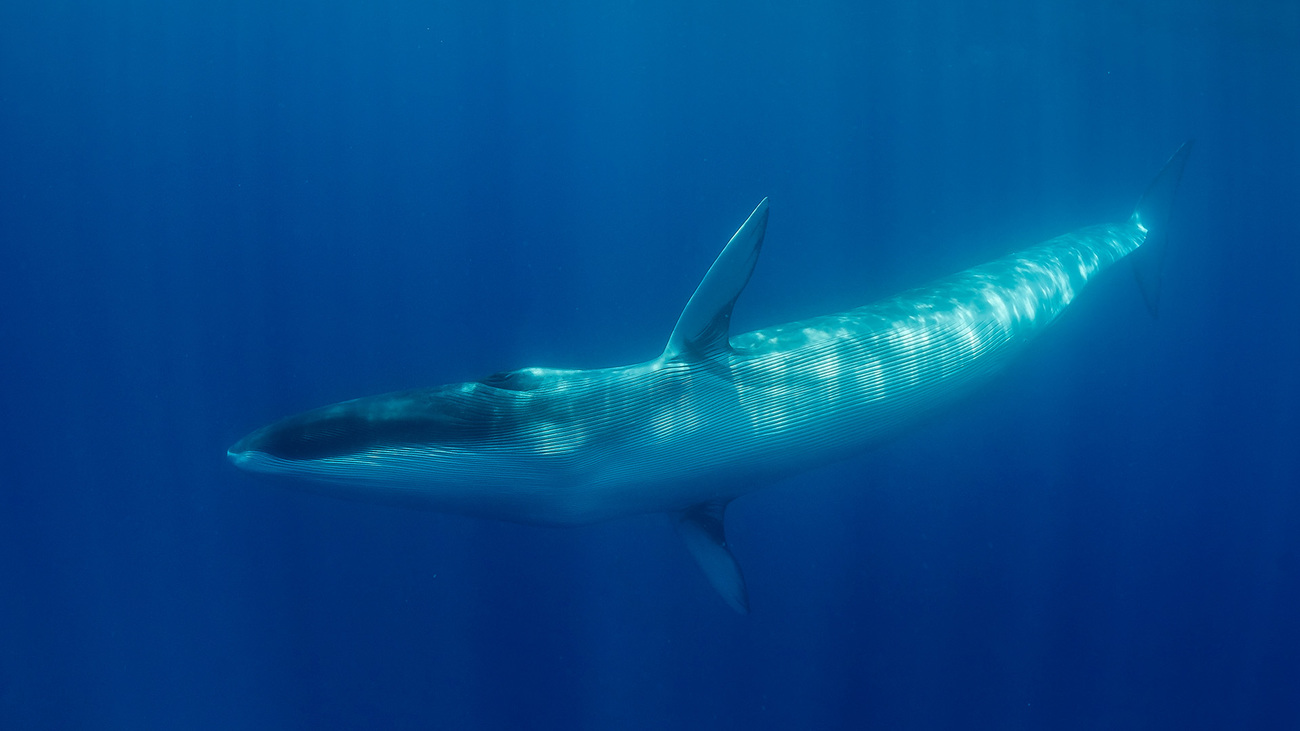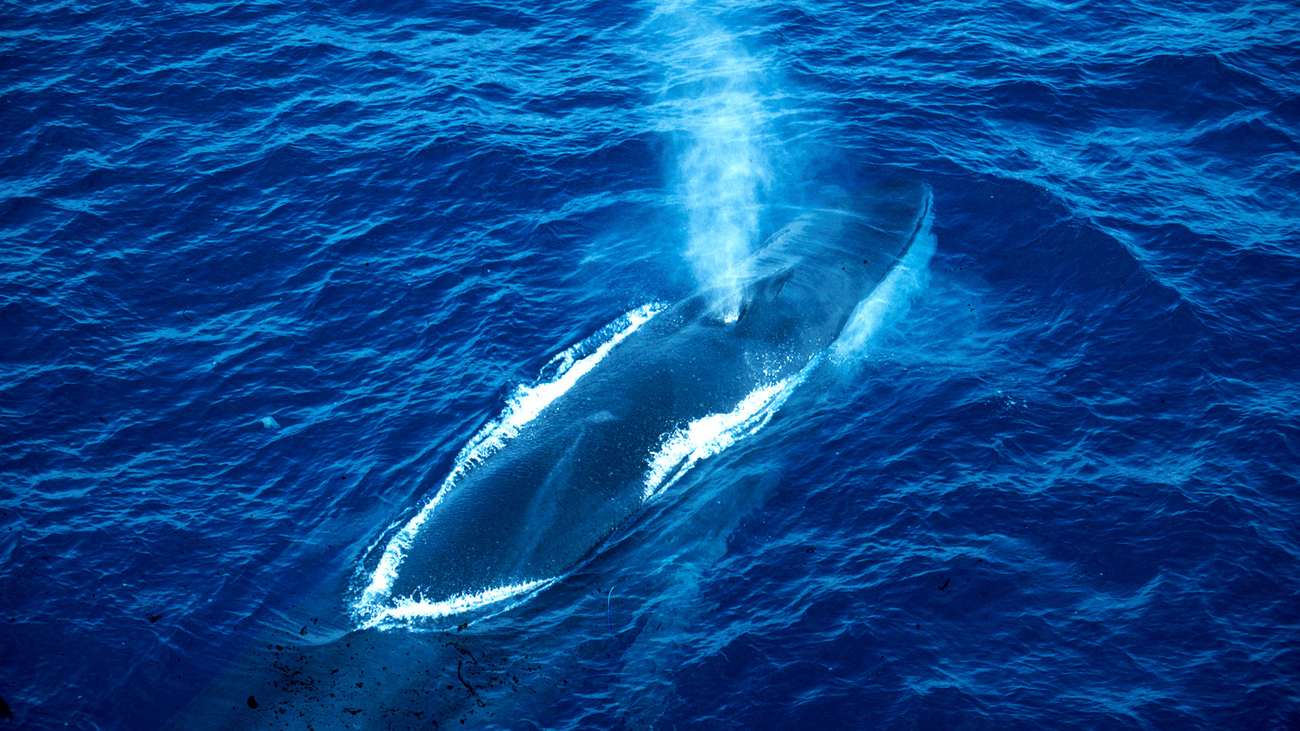Fin whales
What is a fin whale?
Fin whales are the second largest whales in the world, smaller only than the blue whale. When they’re born, fin whales weigh around 1,600 kilograms (3,600 pounds) and grow to about 28 times their birth weight, averaging a massive 45,000 kilograms (99,000 pounds).
The fin whale gets its name from the hooked dorsal fin on its back, which sits close to its tail, around two-thirds of the way down its body. It has a v-shaped head and distinctive coloring—a black, grey, or brown back and sides with a white underside. It has asymmetrical coloring on its jaw, with white on the lower right and dark grey on the lower left.
Fin whales create some of the loudest natural sounds in the ocean, which are often recorded by OBS stations monitoring seismic frequencies. Thought to be breeding displays, male fin whales produce one-second vocalizations up to 40 seconds apart for as long as 10 hours. These sounds are loud enough to be heard more than 30 kilometers (18.6 miles) away.
As one of the largest animals on Earth, fin whales are at the top of the food chain. They are baleen whales, which means they feed by catching water and food in their mouths and filtering the food from the water using long, bristle-like structures called baleen. These plates are made from keratin, the same material as human fingernails. Using this method, fin whales catch and consume various creatures like krill, sand lance, capelin, herring, and squid. They usually eat small schooling fish because their large groups are both easy to spot and provide large amounts of food in one location.
Fin whales play an important role within their ecosystems. When their large bodies dive deeper into the ocean, they help move nutrients around so they reach different plant and animal species. Their feces also help marine plants and phytoplankton to grow and photosynthesize, which produces about half of the oxygen we breathe. They also protect plants by consuming many of the species that feed on them, ensuring the ecosystem stays balanced.
What is a fin whale’s scientific name?
The fin whale’s scientific name is Balaenoptera physalus. The family name, Balaenoptera, is made up of the Latin word for whale and the Greek word for fin, while physalus comes from the Greek word for blow—referring to the fin whale’s ability to blow water from its blowhole over 6 meters (20 feet) into the air.
The fin whale has a few different common names, including the finback whale, razorback whale, common rorqual, and slender baleen whale. The fin whale’s larger cousin, the blue whale, is also part of the Balaenopteridae family.
Are fin whales endangered?
The fin whale is listed as vulnerable on the IUCN Red List. From 1996 to 2018, they were classified as endangered, indicating the species has partially recovered. Their population is reportedly increasing.
In the Southern Hemisphere alone, more than 700,000 fin whales were killed from the early 1900s to the 1970s, which severely depleted their population. Research shows that the fin whale population has increased thanks to regulations on commercial whale hunting. However, other threats to the fin whale’s survival still stand in the way of their full recovery.
Where do fin whales live?
Fin whales are found throughout much of the world. They prefer temperate and subpolar waters and are mostly likely to be found in waters near the equator. However, they have been spotted in tropical areas like Peru and the Seychelles. Fin whales tend to prefer deep waters, far from the coast.
Fin whales are migratory and tend to spend the spring and summer in colder waters before moving to warmer latitudes for the winter breeding season. The exact location of their winter breeding grounds isn’t known. Fin whale migrations aren’t set in stone, however. Some individuals may remain in the colder regions if food is still easily available.
Fin whales are social creatures and tend to live in groups, the sizes of which can vary from just a few individuals to several hundred.
Threats
While the fin whale population is increasing, they still face various threats that could hinder their full recovery. These include further hunting, vessel strikes, entanglement, ocean noise, and climate change.

Hunting
Due to their large size and surprising speed, fin whales were too difficult to catch on traditional boats with traditional methods, so they were largely left alone before the 19th century. However, advancements in ships and hunting techniques during the Industrial Revolution led to fin whales becoming a popular target in the 20th century. They were hunted around the world, starting in Norway and the British Isles and spreading to Spain, Canada, and Greenland. During this period, the fin whale population was reduced by as much as 99%.
After the 1980s, hunting bans were instituted across much of their range, and fin whale populations have been able to bounce back.
However, some countries still allow the practice. Though current hunting levels are more sustainable, there’s still another significant problem—it’s not possible to humanely kill a fin whale. Their size and speed mean hunters cannot guarantee a quick death with minimum suffering. Instead, reports show that as many as 40% of whales suffer slow and painful deaths that can last as long as two hours. Iceland is one of the main countries still allowing the practice. While they introduced a temporary ban on whaling in the summer of 2023, hunting unfortunately resumed in September 2023.
Vessel strikes
When whales collide with ships, they can be gravely injured or killed. Experts estimate that for every reported whale death from a vessel strike, 20 more occur but go undetected. This could mean that hundreds of whales die every year due to vessel strikes.
Entanglement
While it was previously thought that fishing gear mostly affected North Atlantic right whales and humpbacks, more recent studies show that fin whales and possibly blue whales also fall victim to fishing nets. A 2021 study used drones to observe the Gulf of St. Lawrence and reported that between 41% and 57% of fin whales in the area got caught in fishing equipment.
Entanglement poses several threats to whales. If they can’t pull free from the net in time, they drown, because they can’t reach the surface to breathe. When they do break free, they can come away with wounds from the ropes biting into their skin, which can become infected. They might also break the net and bring it with them as they escape. The weight of towing nets around can prevent them from successfully feeding. Even when a whale escapes fishing gear without physical injuries, the extreme stress from the experience can have repercussions and affect their behavior.
Ocean noise
Like other whales and dolphins, fin whales rely heavily on sound to communicate with each other and navigate through the water. Increased ocean noise caused by shipping, oil and gas exploration, naval sonar training, and construction disrupts whale navigation and communication.
In severe cases, noise pollution can lead to whales getting stranded, injured, and even dying. There is no international regulation on ocean noise, so IFAW is currently campaigning to implement vessel speed restrictions to reduce noise, emissions, and ship strikes.
Climate change
Changing ocean temperatures may impact fin whales in several ways, from affecting the type and amount of prey species available to changing the cues that help whales know when to migrate or forage. Whether fin whales will be able to adapt to these changes or not isn’t yet known, but forced changes in their diet could lead to reduced reproduction rates.
FAQs
How many fin whales are left?
After a century of unregulated hunting, it’s estimated that the fin whale population reached lows of between 3,250 and 6,500 by 1980. Now that protections are in place and the species has had around 40 years to recover, the IUCN reports a population size of 100,000 mature individuals and believes the population is continuing to increase.
What are the predators of the fin whale?
Because of their size, fin whales are naturally at the top of the food chain, and no known animals prey on adult individuals. However, fin whale calves do have one natural predator—orcas, also known as killer whales. Fully grown orcas reach around 8 meters (27 feet) in length, so they can attack newborn fin whale calves, which are slightly smaller—around 6 meters (21 feet) long. Fin whale calves can be preyed upon until they grow larger than orcas.
How big do fin whales get?
Fin whales grow to about 21 to 27 meters (69 to 88 feet) long. Females on average are slightly longer than males, but both weigh around 45,000 kilograms (99,000 pounds).

Is a fin whale bigger than a sperm whale?
Fin whales are considerably bigger than sperm whales, beating their average length by 7 meters (23 feet). The only species that beats the fin whale’s 27-meter (88-foot) size is the blue whale, which can reach up to 29 meters (95 feet) long.
How old is the oldest fin whale?
Fin whales live for a long time, becoming physically mature at 25 years and living to around 90 years old on average. However, some fin whales have been known to live even longer. In Denmark, the Natural History Museum studied the eyes and skeleton of a fin whale and determined its age to be between 135 and 140 years.
How much do fin whales eat?
During the summer, fin whales spend large amounts of their day feeding. They travel through the water with their mouths open, taking in massive amounts of water and small creatures—including krill, herring, sand lance, capelin, and squid. They then push the water out, using their baleen to capture the food and keep it in their mouths. Doing this all day long means fin whales consume as much as two kilograms of food daily.
Are fin whales coming back?
Heavy hunting during the 20th century nearly wiped out fin whales and drove them away from their historic breeding grounds. Between 1904 and 1976, over 700,000 whales were killed in the Southern Hemisphere, reducing the population to 1% to 2% of its original size.
After the International Whaling Commission outlawed commercial whaling in the 1980s, it took a long time to start seeing positive effects. Whales are still being hunted commercially in countries like Norway, Japan, and Iceland.
After 2000, reports of fin whales in their traditional feeding grounds in the Antarctic Peninsula finally started to increase—groups of more than 100 individuals were observed in multiple locations. The existence of these large groups and their return to ancestral feeding grounds are promising signs that the population is starting to recover.
Our work
IFAW works to protect marine animals, including whales, across the world.
Though commercial whaling has largely ended, some countries still carry out this barbaric practice. In Iceland, fin whaling is still permitted, and 148 fin whales were killed during the 2022 hunting season alone. A study by the Icelandic government found that over 40% of those whales killed in 2022 suffered slow and painful deaths.
IFAW is working to end Icelandic whaling by focusing on positive marine conservation. We’ve worked with Icelandic whale watching companies and other stakeholders to launch an advocacy campaign and promote activities that protect and celebrate whales. We’re calling on Icelandic authorities to put an end to Icelandic whaling before more of these marine giants fall victim to this cruel practice.
Elsewhere, IFAW also works to prevent vessel strikes, a leading cause of death for fin whales and other whales worldwide. Our European Blue Speeds campaign works to slow down commercial ships in the European Union to reduce collisions, underwater noise pollution, and greenhouse gas emissions.
IFAW joined forces with the Natural Resources Defense Council (NRDC) and the creative agency Imaginary Forces to produce Sonic Sea. This Emmy-winning documentary raises awareness and shows viewers the impact ocean noise pollution has on fin whales and other sea creatures.

How can you help?
With help from our partners and supporters, IFAW has been able to help whales worldwide—but we still have work to do.
You can help us protect fin whales by supporting our whale conservation efforts and programmes and by signing our petition to end commercial whaling in Iceland.
